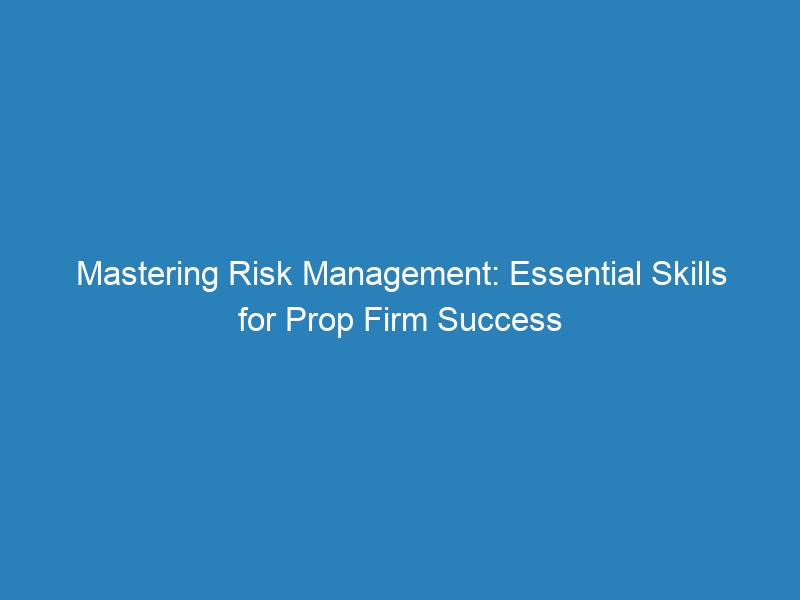Mastering Risk Management: Essential Skills for Prop Firm Success

In the dynamic world of foreign exchange (FX) trading, risk management emerges as a cornerstone for the success of proprietary trading firms. These firms, which trade with their own capital rather than client funds, face a myriad of risks that can significantly impact their profitability and sustainability. Effective risk management not only safeguards the firm’s capital but also enhances decision-making processes, allowing traders to navigate the volatile FX market with greater confidence.
By establishing a robust risk management framework, FX prop firms can mitigate potential losses and capitalize on profitable opportunities, ultimately leading to long-term success. The importance of risk management in FX prop trading cannot be overstated. It serves as a guiding principle that informs trading strategies and operational practices.
A well-structured risk management approach enables firms to identify, assess, and prioritize risks, ensuring that they are prepared for adverse market conditions. Furthermore, it fosters a culture of discipline among traders, encouraging them to adhere to predefined risk parameters and avoid impulsive decisions that could jeopardize their capital. In essence, risk management acts as a safety net, allowing FX prop firms to thrive in an environment characterized by uncertainty and rapid fluctuations.
Key Takeaways
- Risk management plays a crucial role in the success of FX prop firms
- Key risk factors in FX prop trading include market risk, credit risk, and operational risk
- Effective risk management strategies for FX prop trading involve setting risk limits, diversifying portfolios, and using hedging techniques
- Implementing risk management tools and technologies such as risk analytics software and automated trading systems can enhance risk management in FX prop trading
- Monitoring and evaluating risk in FX prop trading is essential for identifying potential issues and making informed decisions; adapting and evolving risk management practices is necessary for FX prop firm success
Identifying Key Risk Factors in FX Prop Trading
To effectively manage risk, FX prop firms must first identify the key risk factors that can influence their trading outcomes. One of the most significant risks in FX trading is market risk, which arises from fluctuations in currency prices. These price movements can be driven by various factors, including economic indicators, geopolitical events, and changes in monetary policy.
Understanding these influences is crucial for traders, as they can lead to substantial gains or losses within a short period. By staying informed about global economic trends and market sentiment, traders can better anticipate potential price movements and adjust their strategies accordingly. Another critical risk factor is liquidity risk, which pertains to the ability to execute trades without causing significant price changes.
This can result in slippage, where trades are executed at less favorable prices than anticipated. Additionally, operational risks, such as technical failures or human errors, can also pose significant threats to FX prop firms.
By recognizing these key risk factors, firms can develop targeted strategies to mitigate their impact and enhance overall trading performance.
Developing Effective Risk Management Strategies for FX Prop Trading
Once key risk factors have been identified, the next step for FX prop firms is to develop effective risk management strategies tailored to their specific trading environments. One fundamental strategy is the implementation of position sizing techniques, which dictate how much capital should be allocated to each trade based on the trader’s risk tolerance and the volatility of the currency pair being traded. By carefully determining position sizes, traders can limit their exposure to any single trade and protect their overall capital from significant drawdowns.
Another essential component of a comprehensive risk management strategy is the establishment of stop-loss orders. These orders automatically close a position when it reaches a predetermined loss level, thereby preventing further losses from accumulating. By setting stop-loss levels based on technical analysis or volatility measures, traders can create a safety net that allows them to manage their risk effectively while still participating in potential market upside.
Additionally, incorporating diversification into trading strategies can help spread risk across multiple currency pairs or asset classes, reducing the impact of adverse movements in any single market.
Implementing Risk Management Tools and Technologies in FX Prop Trading
In today’s technologically advanced trading landscape, FX prop firms have access to a wide array of risk management tools and technologies that can enhance their risk mitigation efforts. Trading platforms often come equipped with built-in risk management features such as real-time analytics, automated stop-loss orders, and margin calculators. These tools enable traders to monitor their positions closely and make informed decisions based on current market conditions.
Moreover, advanced algorithmic trading systems can be employed to execute trades based on predefined risk parameters. These systems can analyze vast amounts of market data in real time, identifying potential trading opportunities while adhering to strict risk management guidelines. Additionally, firms can leverage data analytics and machine learning techniques to assess historical performance and refine their risk management strategies over time.
By embracing these technologies, FX prop firms can enhance their ability to manage risk effectively and improve overall trading outcomes.
Monitoring and Evaluating Risk in FX Prop Trading
Continuous monitoring and evaluation of risk are vital components of an effective risk management framework in FX prop trading. Firms must establish key performance indicators (KPIs) that provide insights into their trading performance and risk exposure. These KPIs may include metrics such as drawdown levels, win-to-loss ratios, and overall portfolio volatility.
By regularly reviewing these indicators, traders can gain valuable insights into their performance trends and make necessary adjustments to their strategies. Furthermore, conducting regular stress tests can help firms assess how their portfolios would perform under extreme market conditions. By simulating various scenarios—such as sudden currency devaluations or geopolitical crises—traders can identify vulnerabilities within their strategies and take proactive measures to address them.
This ongoing evaluation process not only enhances risk awareness but also fosters a culture of continuous improvement within the firm.
Adapting and Evolving Risk Management Practices for FX Prop Firm Success
The foreign exchange market is inherently dynamic, with conditions constantly changing due to economic developments and geopolitical events. As such, FX prop firms must remain agile in their approach to risk management. Adapting and evolving risk management practices is essential for maintaining a competitive edge in this fast-paced environment.
Firms should regularly review and update their risk management frameworks to reflect new market realities and emerging risks. In addition to internal evaluations, seeking external insights from industry experts and participating in professional networks can provide valuable perspectives on best practices in risk management. Engaging with peers allows firms to share experiences and learn from one another’s successes and challenges.
By fostering a culture of collaboration and knowledge-sharing, FX prop firms can enhance their resilience against market uncertainties and position themselves for sustained success in the ever-evolving landscape of foreign exchange trading. In conclusion, effective risk management is integral to the success of FX proprietary trading firms. By understanding the role of risk management, identifying key risk factors, developing targeted strategies, implementing advanced tools, monitoring performance continuously, and adapting practices as needed, these firms can navigate the complexities of the FX market with confidence.
Ultimately, a robust risk management framework not only protects capital but also empowers traders to seize opportunities for growth in an unpredictable environment.
FAQs
What is risk management?
Risk management is the process of identifying, assessing, and prioritizing risks, and then applying resources to minimize, monitor, and control the probability or impact of these risks.
Why is risk management important for prop firms?
Risk management is crucial for prop firms because it helps them to protect their capital, minimize potential losses, and ensure the long-term sustainability of their business. It also allows them to make more informed decisions and take calculated risks.
What are the essential skills for mastering risk management in prop firms?
Some essential skills for mastering risk management in prop firms include quantitative analysis, understanding of financial markets, knowledge of risk assessment techniques, and the ability to develop and implement risk management strategies.
How can prop firms improve their risk management practices?
Prop firms can improve their risk management practices by implementing robust risk management policies and procedures, utilizing risk management tools and technologies, conducting regular risk assessments, and providing ongoing training and education for their staff.
What are the potential consequences of poor risk management in prop firms?
Poor risk management in prop firms can lead to significant financial losses, reputational damage, regulatory issues, and even the failure of the business. It can also result in missed opportunities and hinder the firm’s ability to grow and succeed in the market.



Recent Comments